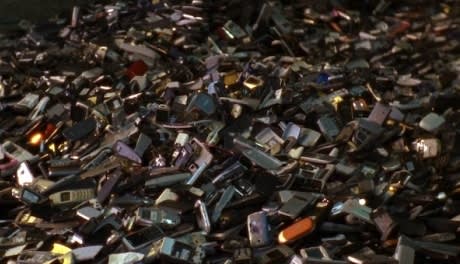In this thoughtful film essay, Sarah J. Christman investigates the ever-changing nature of matter, both personal and public. Everything is impermanent. Everything is ephemeral. Everything, from human beings to man-made products, dies in its own way. As Above, So Below looks at some contemporary instances of "alchemy"—the transformation of a loved one's ashes into a "memorial diamond;" the recycling of products to recover and reuse the metal they contain; the conversion of one of the world's largest landfills, once visible to the naked eye from space, into a public park—and investigates the meaning of matter.
In the main story, which is woven throughout the film and provides its affective core, a woman goes through the process of turning her husband's ashes into a diamond. As Above, So Below takes a somewhat distanced approach to showing this woman, especially during the opening section. The woman's face is rarely revealed. Her body is seen mostly from the shoulders down or in close-up detail. We never see her speaking the words we hear. This respectful remove places some emotional space between the audience and the woman, occasionally to the detriment of her story. (The end credits suggest that this woman is the filmmaker's mother, making the reserved manner in which her physical self is presented seem like a protective choice.)
When this woman articulates her husband's battle with cancer, her words are synched to images of trees and garbage—garbage on the ground, in bins, stacked high and wide. This is one of two heavy-handed moments in the film that pull you out of the story being told (the other involves a garbage-truck-lined street beneath a billboard for the movie "Contagion"). Had Christman removed these images of garbage, which seem amateurish and clumsy, and focused solely on the trees changing with each season, or had she included shots of the husband's material objects rendered useless by his death (his glasses, his toothbrush, his clothes), she would have heightened the poignancy and emotional charge of this scene.
Despite a few minor flaws, As Above, So Below is an intriguing film that grapples with important ideas about materiality, mortality, and time in a thought-provoking manner. Christman even succeeds in discussing garbage in philosophical rather than preachy terms. Why do we keep what we keep or throw away what we discard? Why do we have such difficulty letting go of some things and such an easy time letting go of others? How much of ourselves is reflected in the objects we keep and what happens to these objects after we die?
(Independent)In the main story, which is woven throughout the film and provides its affective core, a woman goes through the process of turning her husband's ashes into a diamond. As Above, So Below takes a somewhat distanced approach to showing this woman, especially during the opening section. The woman's face is rarely revealed. Her body is seen mostly from the shoulders down or in close-up detail. We never see her speaking the words we hear. This respectful remove places some emotional space between the audience and the woman, occasionally to the detriment of her story. (The end credits suggest that this woman is the filmmaker's mother, making the reserved manner in which her physical self is presented seem like a protective choice.)
When this woman articulates her husband's battle with cancer, her words are synched to images of trees and garbage—garbage on the ground, in bins, stacked high and wide. This is one of two heavy-handed moments in the film that pull you out of the story being told (the other involves a garbage-truck-lined street beneath a billboard for the movie "Contagion"). Had Christman removed these images of garbage, which seem amateurish and clumsy, and focused solely on the trees changing with each season, or had she included shots of the husband's material objects rendered useless by his death (his glasses, his toothbrush, his clothes), she would have heightened the poignancy and emotional charge of this scene.
Despite a few minor flaws, As Above, So Below is an intriguing film that grapples with important ideas about materiality, mortality, and time in a thought-provoking manner. Christman even succeeds in discussing garbage in philosophical rather than preachy terms. Why do we keep what we keep or throw away what we discard? Why do we have such difficulty letting go of some things and such an easy time letting go of others? How much of ourselves is reflected in the objects we keep and what happens to these objects after we die?
